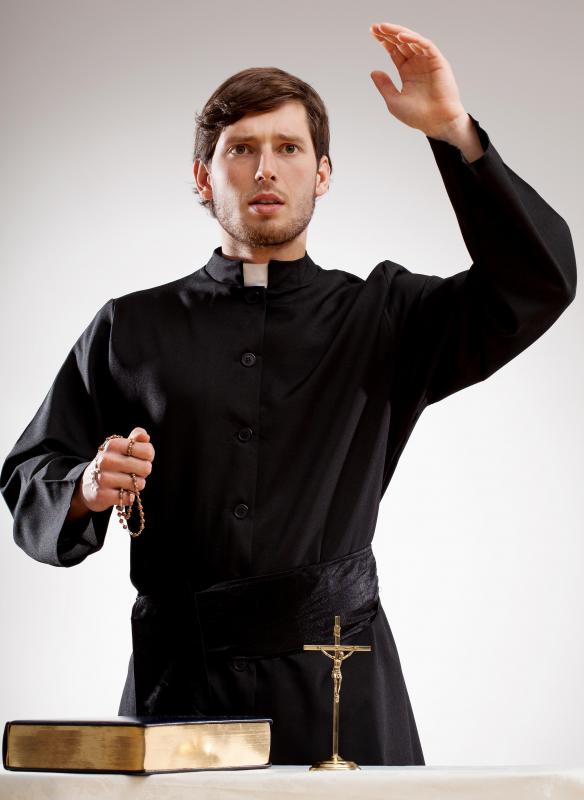At PracticalAdultInsights, we're committed to delivering accurate, trustworthy information. Our expert-authored content is rigorously fact-checked and sourced from credible authorities. Discover how we uphold the highest standards in providing you with reliable knowledge.
How Do I Become an Archbishop?
Archbishop is a high rank in the hierarchies of the Catholic, Orthodox and Anglican churches. Decades of service are required if you want to become an archbishop. All bishops and archbishops are ordained members of the priesthood of those particular churches, though the other specifics of what is required to become an archbishop vary between churches. Most people bearing the title of archbishop are part of the hierarchy of the Catholic Church.
In the modern Catholic Church, a man seeking to enter the priesthood must undergo several years of training in a seminary, where he is trained in the duties of a priest and in Catholic philosophy and theology. This generally takes four to eight years, depending on factors such as his prior education. Toward the end of this training, usually in the last year, he is ordained as a deacon. Deacons assist priests in their duties and can preach sermons. They can perform witness marriages and perform baptisms, but cannot perform other sacraments, such as consecrating the Eucharist or hearing confession and granting absolution of the penitent's sins.

After about six months as a deacon, the candidate can be ordained as a presbyter. This requires him to take vows of chastity, obedience and poverty and to receive ordination through laying on of hands by a bishop. He is then assigned to a church and its parish. Presbyters are what most people are usually referring to when they talk about Catholic priests, and they are responsible for celebrating Mass, blessing the Eucharist during Communion and for sacraments such as baptism, penance and the anointing of the sick. He also oversees the church's daily liturgy, performs administrative duties and provides spiritual assistance to Catholics in the parish.

After a period of service, the presbyter is eligible to be ordained as a bishop, the highest level of Holy Orders. Church laws require that a bishop be at least 35 years old, have served as a presbyter for at least five years and be regarded as someone of high piety and integrity. He must be an expert in Catholic theology and law, which often entails a doctoral degree in these fields. A diocesan bishop has authority over all churches and lower priests within the diocese for which he is responsible, called his see. A bishop can also serve as assistant to a diocesan bishop, archbishop or metropolitan. He can also serve in the church's central administration in Rome, the Curia, or as a papal envoy.
Bishops within an ecclesiastical province, an administrative division containing several dioceses, periodically draw up lists of of priests they consider suitable to become bishops. When an existing bishop resigns or dies, a representative of the Pope consults with the bishops of the ecclesiastical province — including the one departing the office to be filled, if he is still alive — about these candidates. He then further investigates each candidate and sends a short list of those he considers most suitable to whichever congregation of the Curia in Rome is responsible for filling the vacancy, which varies depending on where the vacancy is. The Curia then selects a new bishop, who usually is someone from this list of recommendations but is not necessarily so, and presents its decision to the Pope, who has final authority to ratify or reject the choice.
Unlike the difference between deacons, presbyters and bishops, rising to the rank of archbishop does not entail a higher level of Holy Orders, so an additional ordination is not required to become an archbishop. A metropolitan archbishop is a church official who has authority over a see called an archdiocese and oversees several other dioceses and their bishops as well. In some cases, an archbishop might govern only one see, as is the case in countries that are too small to be divided into multiple dioceses.
Appointment to an archdiocese is done in the same way as other dioceses, though the greater prestige and authority of the office of archbishop means that the process is more selective. In some cases, the title of archbishop is also personally granted as a special honor to a bishop who is assigned to a diocese rather than an archdiocese, though this rank does not transfer to his future successor as that see's bishop. A bishop serving in the Curia or as a papal envoy will sometimes become an archbishop in a similar way.
AS FEATURED ON:
AS FEATURED ON:












Discussion Comments
For half the candidates this would, of course, involve a sex change.
Post your comments